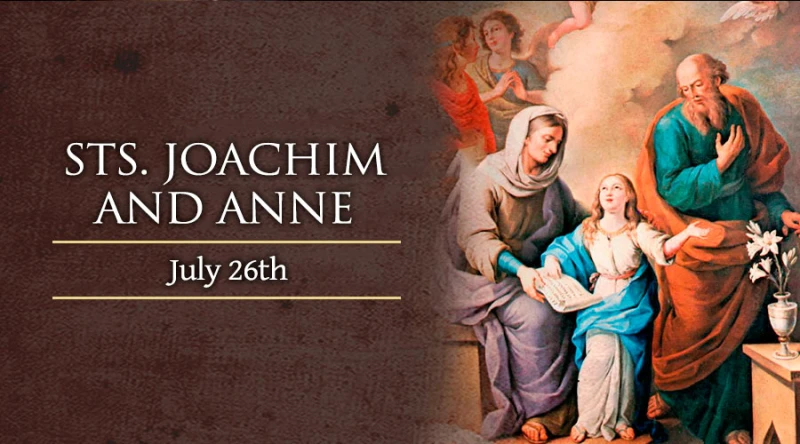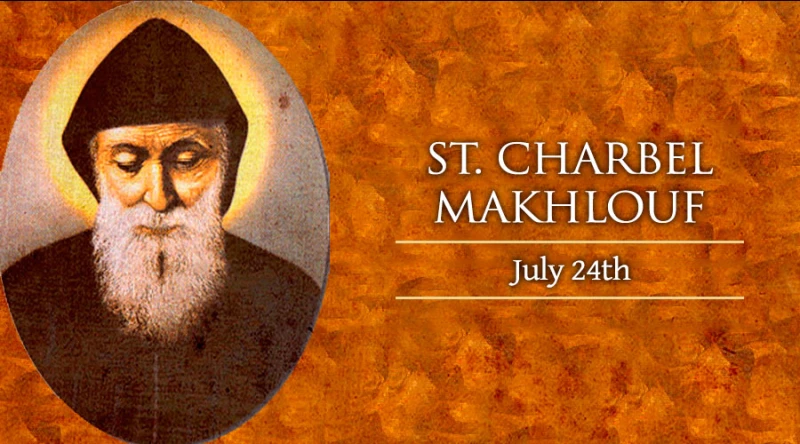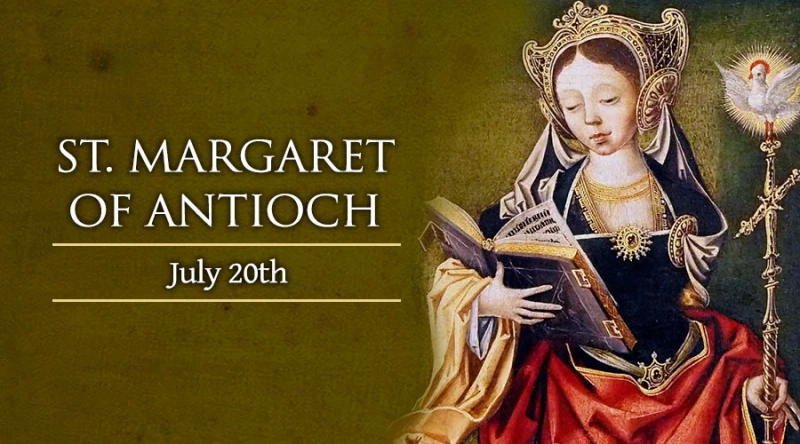Sts. Anne and Joachim

Sts. Anne and Joachim
Feast date: Jul 26
On July 26 the Roman Catholic Church commemorates the parents of the Virgin Mary, Saints Joachim and Anne. The couple’s faith and perseverance brought them through the sorrow of childlessness, to the joy of conceiving and raising the immaculate and sinless woman who would give birth to Christ.
The New Testament contains no specific information about the lives of the Virgin Mary’s parents, but other documents outside of the Biblical canon do provide some details. Although these writings are not considered authoritative in the same manner as the Bible, they outline some of the Church’s traditional beliefs about Joachim, Anne and their daughter.
The “Protoevangelium of James,” which was probably put into its final written form in the early second century, describes Mary’s father Joachim as a wealthy member of one of the Twelve Tribes of Israel. Joachim was deeply grieved, along with his wife Anne, by their childlessness. “He called to mind Abraham,” the early Christian writing says, “that in the last day God gave him a son Isaac.”
Joachim and Anne began to devote themselves to rigorous prayer and fasting, in isolation from one another and from society. They regarded their inability to conceive a child as a surpassing misfortune, and a sign of shame among the tribes of Israel.
As it turned out, however, the couple were to be blessed even more abundantly than Abraham and Sarah. An angel revealed this to Anne when he appeared to her and prophesied that all generations would honor their future child: “The Lord has heard your prayer, and you shall conceive, and shall bring forth; and your seed shall be spoken of in all the world.”
After Mary’s birth, according to the Protoevangelium of James, Anne “made a sanctuary” in the infant girl’s room, and “allowed nothing common or unclean” on account of the special holiness of the child. The same writing records that when she was one year old, her father “made a great feast, and invited the priests, and the scribes, and the elders, and all the people of Israel.”
“And Joachim brought the child to the priests,” the account continues, “and they blessed her, saying: ‘O God of our fathers, bless this child, and give her an everlasting name to be named in all generations’ … And he brought her to the chief priests; and they blessed her, saying: ‘O God most high, look upon this child, and bless her with the utmost blessing, which shall be forever.’”
The protoevangelium goes on to describe how Mary’s parents, along with the temple priests, subsequently decided that she would be offered to God as a consecrated Virgin for the rest of her life, and enter a chaste marriage with the carpenter Joseph.
St. Joachim and St. Anne have been a part of the Church’s liturgical calendar for many centuries. Devotion to their memory is particularly strong in the Eastern Catholic churches, where their intercession is invoked by the priest at the end of each Divine Liturgy. The Eastern churches, however, celebrate Sts. Joachim and Anne on a different date, Sept. 9.
St. James

St. James
Feast date: Jul 25
James, the brother of John the Evangelist, was the first Apostle to be martyred. He was beheaded by order of Herod of Agrippa. The Gospels tell us that the two brothers left their father, Zebedee, and followed Jesus as soon as He called out to them.
James was one of the three Apostles who were particularly close to the Lord. He was there with the Lord and his brother, John, and Peter at the Transfiguration and in the Garden of Gethsemane.
He is known as James “the Greater” to distinguish him from the other Apostle by the same name. The title has little to do with his function or the people’s regard for him. Rather, it was a term indicating that he was the elder of the two.
He is the patron saint of Spain and of pilgrims. In northwestern Spain, he is venerated at Santiago de Compostela, a mediaeval pilgrimage site that is still very popular today.
St. Charbel Makhlouf

St. Charbel Makhlouf
Feast date: Jul 24
On July 24, the Catholic Church celebrates the life of St. Charbel Makhlouf, a Maronite Catholic priest, monk, and hermit who is known for working miracles both during his life and after his death.
On the occasion of his beatification in 1965, the Eastern Catholic hermit was described by Pope Paul VI as “ a new, eminent member of monastic sanctity,” who “through his example and his intercession is enriching the entire Christian people.”
Born into humble circumstances in Lebanon during 1828, Yussef Antoun Makhlouf was the youngest of Antoun Zaarour Makhlouf and Brigitta Elias al-Shediyaq’s five children. Antoun, who had been taken away from the family and forced into hard labor, died when his youngest son was only three.
Yussef studied at the parish school and tended to his family’s cow. Engaged in prayer and solitude from a early age, he spent a great deal of time outdoors in the fields and pastures near his village, contemplating God amid the inspiring views of Lebanon’s valleys and mountains.
His uncle and guardian Tanious wanted the boy to continue working with him, while his mother wanted him to marry a young woman. Yussef had other plans, however, and left home in 1851 without informing anyone.
Yussef would become “Brother Charbel,” after making a pilgrimage on foot to his new monastic home. In this, he followed the example of his maternal uncles, who were already living as solitary monks at the Hermitage of Saint Paul in the Qadisha Valley.
Charbel took his monastic vows in November of 1853, during a solemn ceremony which was closed to the public and off-limits even to his family. He subsequently studied for the priesthood and was ordained, returning to the Monastery of St. Maron.
The priest-monk lived and served in the monastery for 19 years, showing great devotion to the life of prayer, manual work, and contemplative silence.
Charbel’s superiors observed God’s “supernatural power” at work in his life, and he became known as a wonder-worker even among some Muslims. In 1875, he was granted permission to live as a solitary monk in a nearby hermitage dedicated to Saints Peter and Paul.
Rigorous asceticism, and a profound union with God, continued to characterise the monk’s life for the next 23 years. Deeply devoted to God’s Eucharistic presence, he suffered a stroke while celebrating the Divine Liturgy of the Maronite Catholic Church on December 16, 1898. He died on Christmas Eve of that year.
St. Charbel’s tomb has been a site for pilgrimages since his death. Hundreds of miracles are believed to have occurred through his intercession with God, both in Lebanon and around the world.
He was canonised in 1977 by Pope Paul VI, who had earlier hailed the Lebanese Maronite saint as an “admirable flower of sanctity blooming on the stem of the ancient monastic traditions of the East.”
St. Bridget of Sweden

St. Bridget of Sweden
Feast date: Jul 23
Today, July 23, the Church celebrates the feast day of St. Bridget of Sweden. Bridget received visions of Christ’s suffering many times throughout her life, and went on to found the order of the Most Holy Savior.
Daughter of Birger Persson, the governor and provincial judge of Uppland, and of Ingeborg Bengtsdotter, Bridget was born in Sweden in 1303. From the time she was a child, she was greatly devoted to the passion of Jesus.
When she was only ten, it is recorded that she had a vision of Jesus on the cross and heard him say, “Look at me, my daughter.”
“Who has treated you like this?” cried little Bridget.
Jesus answered, “Those who despise me and refuse my love for them.” From that moment on, Bridget tried to stop people from offending Jesus.
When she was 14, Bridget married an 18-year old man named Ulf. Like Bridget, Ulf had set his heart on serving God. They had eight children, of whom one was St. Catherine of Sweden. Bridget and Ulf also served the Swedish court, Bridget as the queen’s personal maid. Bridget tried to help King Magnus and Queen Blanche lead better lives, however for the most part, they did not listen to her.
All her life, Bridget had marvelous visions and received special messages from God. In obedience to them, she visited many rulers and important people in the Church. She explained humbly what God expected of them.
After her husband died, Bridget put away her rich clothes and lived as a poor nun. Later, in 1346, she began the order of the Most Holy Savior, also known as Bridgettines. She still kept up her own busy life, traveling about doing good everywhere she went. And through all this activity, Jesus continued to reveal many secrets to her, which she received without the least bit of pride.
Shortly before she died, the saint went on a pilgrimage to the Holy Land. At the shrines there, she had visions of what Jesus had said and done in each place.
All St. Bridget’s revelations on the sufferings of Jesus were published after her death.
St. Bridget died in Rome on July 23, 1373. She was proclaimed a saint by Pope Boniface IX in 1391.
“True wisdom, then, consists in works, not in great talents, which the world admires; for the wise in the world’s estimation . . . are the foolish who set at naught the will of God, and know not how to control their passions.” –Saint Bridget of Sweden.
St. Mary Magdalene

St. Mary Magdalene
Feast date: Jul 22
On July 22, the Church celebrates the Feast of St. Mary Magdelene, one of the most prominent women mentioned in the New Testament.
Her name comes from the town of Magdala in Galilee, where she was born. Scripture introduces her as a woman “who had been healed of evil spirits and infirmities: Mary, called Magdalene, from whom seven demons had gone out” (Lk. 8:2).
Some scholars identify Mary Magdalene with the sinful woman who anointed the feet of Christ with oil in the house of Simon the Pharisee (Lk. 7:36-50). Others associate her with Mary, the sister of Martha and Lazarus (Lk. 10:38-42, Jn. 11). Some believe the three figures to be one person, while others believe them to be three distinct individuals.
What the Scriptures make certain about Mary Magdalene is that she was a follower of Christ, who accompanied and ministered to him (Lk. 8:2-3). The Gospels record her as being one of the women present at Christ’s crucifixion.
In addition, she was the first recorded witness of the Resurrection. The Gospels all describe Mary Magdalene going to the tomb on Easter morning. When she saw that the tomb was empty, she stood outside, weeping. Jesus appeared to her and asked her, “Woman, why are you weeping? Whom are you looking for?” (Jn. 20:15)
She did not recognize him, however, and thought he was the gardener, until he said her name, “Mary!” (Jn. 20:16) Upon hearing this, Mary recognized him. She returned to the grieving disciples to announce to them the message of the Resurrection.
Pope Benedict XVI spoke about Mary Magdalene in his address before the Angelus on July 23, 2006. He referred to her as “a disciple of the Lord who plays a lead role in the Gospels.”
The Pope recalled Mary Magdalene’s presence “beneath the Cross” on Good Friday, as well as how “she was to be the one to discover the empty tomb” on Easter morning.
“The story of Mary of Magdala reminds us all of a fundamental truth,” Pope Benedict said. “A disciple of Christ is one who, in the experience of human weakness, has had the humility to ask for his help, has been healed by him and has set out following closely after him, becoming a witness of the power of his merciful love that is stronger than sin and death.”
On June 10, 2016, the liturgical celebration honoring St. Mary Magdalene was raised from a memorial to a feast, putting her on par with the apostles.
St. Lawrence of Brindisi

St. Lawrence of Brindisi
Feast date: Jul 21
St. Lawrence of Brindisi, whose feast we celebrate on July 21, is a Doctor of the Church. He was born Caesar de Rossi in 1559 in Naples. As a boy, he studied with the Conventual Franciscans and later went to study in Venice. There he discerned a call to enter the Capuchin Franciscans and took the name Lawrence.
Fluent in Hebrew and expertly versed in the Bible, he worked as a diplomat for the secular powers in Europe and as a missionary. In 1596, he was commissioned by the Pope to work for the conversion of the Jewish people and to combat the spread of Protestantism. He was a great preacher and refused a second term as minister general of his order in favor of preaching. He died in 1619.
St. Margaret of Antioch

St. Margaret of Antioch
Feast date: Jul 20
Saint Margaret, whose feast is celebrated on July 20, is a virgin and martyr. She is also called “Marina”. Margaret belonged to Pisidian Antioch in Asia Minor, where her father was a pagan priest. Her mother died soon after Margaret’s birth, so she was nursed by a pious woman who lived about five or six leagues from Antioch. Having embraced Christianity and consecrated her virginity to God, she was disowned by her father and adopted by her nurse.
One day, while she was engaged in watching the flocks of her mistress, a lustful Roman prefect named Olybrius caught sight of her, and attracted by her great beauty sought to make her his concubine or wife. When neither cajolery nor threats of punishment could succeed in moving her to yield to his desires, he had her brought before him in public trial at Antioch. Threatened with death unless she renounced the Christian faith, the holy virgin refused to adore the gods of the empire. An attempt was made to burn her, but the flames, we are told in her Acts, left her unharmed. She was then bound hand and foot and thrown into a cauldron of boiling water, but at her prayer her bonds were broken and she stood up uninjured. Finally the prefect ordered her to be beheaded.
The Greek Church honors her under the name Marine on July13, and the Latin, as Margaret on July 20. Her Acts place her death in the persecution of Diocletian (A.D. 303-5), but in fact even the century to which she belonged is uncertain. St. Margaret is represented in art sometimes as a shepherdess, or as leading a chained dragon, again carrying a little cross or a girdle in her hand, or standing by a large vessel which recalls the cauldron into which she was plunged. Relics said to belong to the saint are venerated in very many parts of Europe; at Rome, Montefiascone, Brusels, Bruges, Paris, Froidmont, Troyes, and various other places. Curiously enough this virgin has been widely venerated for many centuries as a special patron of women who are pregnant.
